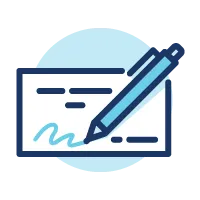Key Takeaways
- Debt can serve as a valuable tool when used wisely for investments like a home or education. However, high-interest debts can quickly become a financial trap if not managed carefully.
- It’s important to develop a plan for repaying debt and prioritize by focusing on high-interest ones first.
- Creating a realistic budget, establishing an emergency fund, and considering debt consolidation can all help you manage debt effectively.
While you’re likely familiar with the concept of debt, its role in personal finance is often misunderstood. For many, the term "debt" carries a negative connotation, raising questions like, "Is debt good or bad?" The answer is that it can be both, which makes debt tricky.
Here we'll cover everything you need to know about debt, how it impacts your finances, and how to approach different types of debt.
What is Debt?
Let’s start with a basic definition to answer our question: What is debt?
At its core, debt is essentially borrowed money, a financial arrangement where one party borrows funds from another with the promise of repayment, usually with interest.
Debt involves two primary parties: the borrower and the lender. The borrower seeks financial assistance, agreeing to repay the borrowed amount along with any applicable interest within a specified time frame.
Living without debt is becoming increasingly harder to do in America. According to the Federal Reserve Bank, total American consumer debt balances rose to $17.06 trillion in 2023, a 4.15% increase over the past year.
The average amount of debt Americans carry varies by type:
- Housing debt: As of the third quarter of 2022, the average mortgage debt balance was $236,443, according to Experian. For HELOCs, the average balance was $41,045.
- Student loan debt: The average student loan debt per borrower in 2023 was $37,338 in federal student loans and $54,921 in private student loans.
- Credit card debt: As of the third quarter of 2022, the average American adult held $5,910 in credit card debt, according to Experian.
What to Know About Debt: Types, Interest Rates, and Terms and Conditions
Debt comes in various forms, each serving different purposes. Common forms of debt include loans, credit cards, mortgages, and lines of credit. Being able to borrow funds like this allows you to make substantial purchases or investments without the immediate need to pay in full.
If you’re wondering what is debt, you’re likely curious about how interest works too. Interest represents the cost of borrowing money. The interest rate attached to a debt determines how much extra you must repay. When borrowing money, it’s important to understand your interest rate because it significantly impacts the overall cost of the borrowed funds.
Debt agreements come with specific terms and conditions, outlining the repayment schedule, interest rates, and any penalties for late payments. These terms vary depending on the type of debt and the lending institution.
Keep in mind that debt can be both a strategic financial tool and a potential burden, depending on how it's used. While it allows you to achieve significant life goals, such as homeownership or education, mismanagement can lead to financial stress and difficulties.
Now that you have the foundational knowledge about debt, let’s further explore its different types and how to manage it effectively.
Types of Debt
When managed wisely, debt can facilitate major life events such as purchasing a home, financing education, or starting a business. Understanding the different types of debt and their impacts on your long-term finances can help you make good decisions about what debt you take on. Here are the different categories of debt.
Secured Debt
Secured debt is backed by collateral, providing a level of security for the lender. Mortgages and auto loans are common examples of secured debt. In these cases, if you fail to repay, the lender has the right to seize the collateral to recover the outstanding amount.
Unsecured Debt
Unlike secured debt, unsecured debt is not tied to any specific asset. Lenders extend credit based on your creditworthiness and promise to repay. Credit cards, medical bills, and most personal loans fall into the category of unsecured debt. Due to the absence of collateral, interest rates on unsecured debt are often higher.
Revolving Debt
Revolving debt allows you to repeatedly borrow and repay up to a predetermined credit limit. Credit cards are a classic example of revolving debt. Users can make purchases, pay them off, and then use the credit again. Managing revolving debt requires discipline, as your balance can quickly accumulate if not handled responsibly.
Installment Debt
Installment debt involves borrowing a fixed amount and repaying it in regular, predetermined installments over time. Mortgages, auto loans, and personal loans with fixed monthly payments fall into this category. Installment debt provides predictability, making it easier to plan your budget.
How to Approach Debt
Now you have a good understanding of what debt is and all its different types, but how do you manage debt effectively? Here are some tips for approaching and managing debt.
- Prioritize high-interest debt: Tackle high-interest debts like credit cards first to minimize interest payments and break the cycle of accumulating debt.
- Create a budget: Develop a realistic budget that accounts for your essential expenses and allocates funds toward debt repayment.
- Build your emergency fund: Establishing an emergency fund can prevent you from relying on high-interest debt when unexpected expenses arise.
- Consider debt consolidation: If you have multiple high-interest debts, consolidating them into a single, lower-interest payment may be a viable option.
Is Debt Good or Bad?
The answer to whether debt is good or bad depends on how it's managed. Responsible use of debt to invest in assets that appreciate over time can be beneficial. On the other hand, accumulating high-interest debt without a plan for repayment can lead to financial strain.
Good Debt Examples
- Mortgage: Buying a home is one of the largest financial investments you’ll make. Mortgages are generally considered "good debt" as they allow you to build equity over time
- Student loans: Investing in education can lead to increased earning potential. While student loans can accumulate, they are often seen as an investment in one's future.
- Business loans: Entrepreneurs may need to take out loans to start or expand a business. When used wisely, these loans can contribute to financial success.
Bad Debt Examples
- Credit card debt: High-interest rates make credit card debt one of the most challenging to manage. While using a credit card comes with rewards like building your credit score or earning cash back, poor credit card spending habits can lead to a cycle of debt.
- Payday loans: These short-term, high-interest loans can provide quick cash but are notorious for trapping individuals in a cycle of debt due to exorbitant interest rates.
Debt Payoff Calculator
Wondering how long it will take you to pay off your debt? Our Debt Payoff Calculator shows how much money you can save in interest by adding additional principal to a monthly payment.
Debt is a financial tool that can either hurt or help your financial situation, depending on how you use and manage it. By understanding the different types of debt and adopting healthy debt management strategies, you can navigate this financial landscape with confidence. Remember when choosing to take on debt, ensure that your choice aligns with your long-term goals.
APR = Annual Percentage Rate












